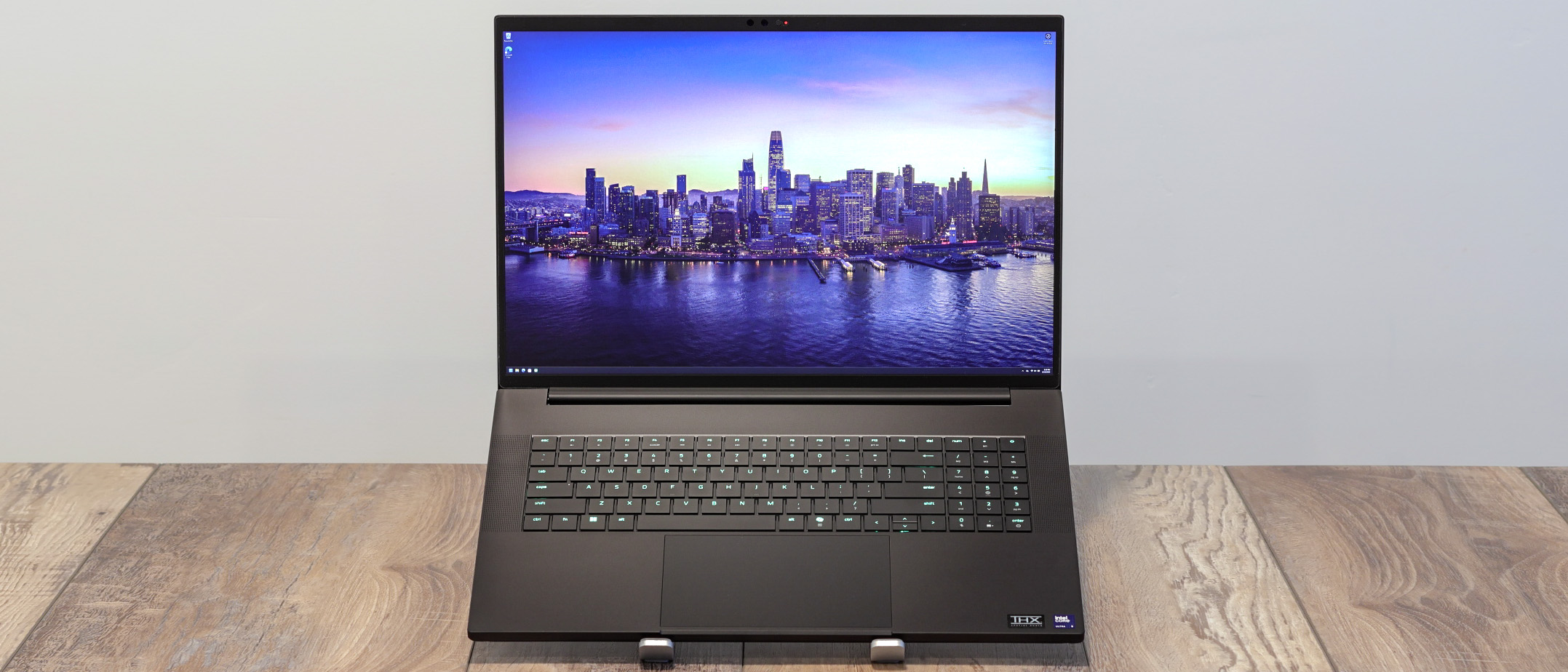
Skip to main content
Tom’s Guide
Newsletters
View Profile
Search Tom’s Guide
Phone Insights
Phone Best Picks
Phone Deals
Phone Face-Offs
Phone How-Tos
Phone Reviews
Network Carriers
Android Phones
Google Phones
Motorola Phones
OnePlus Phones
Samsung Phones
Nothing Phone
TV Best Picks
TV Face-Offs
Audio Insights
Audio Best Picks
Audio Deals
Audio Face-Offs
Audio How-Tos
Audio Reviews
Over-Ear Headphones
Bluetooth Speakers
Smart Speakers
TV & Audio Brands
Entertainment
Streaming Devices
Prime Video
Paramount Plus
PlayStation
Handheld Gaming
Gaming Peripherals
Connections
Computing Insights
Computing Best Picks
Computing Deals
Computing Face-Offs
Computing How-Tos
Computing News
Computing Reviews
VPN Best Picks
VPN Face-Offs
VPN How-Tos
VPN Reviews
Operating Systems
Identity Theft Protection
Parental Controls
Malware & Adware
Virtual Reality
Augmented Reality
Smart Glasses
Chromebooks
Gaming Laptops
Apple Desktops
Gaming Desktops
Android Tablets
Computing Brands
AI Insights
AI Best Picks
AI Face-Offs
Google Gemini
Apple Intelligence
Mattress Best Picks
Mattress Deals
Mattress Face-Offs
Mattress How-Tos
Mattress News
Mattress Reviews
Mattress Care
Mattress Toppers
Pillows & Bedding
Smartwatches
Fitness Trackers
Smart Rings
Apple Watch
Home Insights
Home Best Picks
Home Face-Offs
Home How-Tos
Home Reviews
Home Topics
Home Appliances
Home Office
Home Security
Home Brands
Popular Brands
View Phones
Phone Insights
Phone Best Picks
Phone Deals
Phone Face-Offs
Phone How-Tos
Phone Reviews
Network Carriers
View Network Carriers
Android Phones
View Android Phones
Google Phones
Motorola Phones
OnePlus Phones
Samsung Phones
Nothing Phone
TV Best Picks
TV Face-Offs
Audio Insights
View Audio Insights
Audio Best Picks
Audio Deals
Audio Face-Offs
Audio How-Tos
Audio Reviews
Headphones
View Headphones
Over-Ear Headphones
View Speakers
Bluetooth Speakers
Smart Speakers
TV & Audio Brands
Entertainment
View Entertainment
View Streaming
Streaming Devices
Prime Video
Paramount Plus
View Gaming
PlayStation
Handheld Gaming
Gaming Peripherals
Word Games
Connections
View Computing
Computing Insights
Computing Best Picks
Computing Deals
Computing Face-Offs
Computing How-Tos
Computing News
Computing Reviews
VPN Best Picks
VPN Face-Offs
VPN How-Tos
VPN Reviews
View Hardware
View Software
Operating Systems
View Security
Identity Theft Protection
Parental Controls
Malware & Adware
View VR & AR
Virtual Reality
Augmented Reality
Smart Glasses
View Laptops
Chromebooks
Gaming Laptops
View Desktops
Apple Desktops
Gaming Desktops
View Tablets
Android Tablets
Computing Brands
AI Insights
AI Best Picks
AI Face-Offs
AI Engines
Google Gemini
Apple Intelligence
View Wellness
Mattresses
View Mattresses
Mattress Best Picks
Mattress Deals
Mattress Face-Offs
Mattress How-Tos
Mattress News
Mattress Reviews
Mattress Care
Mattress Toppers
Pillows & Bedding
View Fitness
Smartwatches
Fitness Trackers
Smart Rings
Apple Watch
Home Insights
Home Best Picks
Home Face-Offs
Home How-Tos
Home Reviews
Home Topics
Home Appliances
Home Office
Home Security
View Outdoors
Home Brands
Popular Brands
iPhone 17 Event LIVE
The World in 2035
Best of IFA 2025
Wordle Today
Best laptops
Best Mattress
Don’t miss these
Gaming Laptops
I tested the Razer Blade 14 (2025) — and it may be the perfect on-the-go gaming laptop
Gaming Laptops
I tried the Asus TUF Gaming A18 with an RTX 5070 and it changed my mind about 18-inch gaming laptops
Gaming Laptops
I swapped a gaming desktop for a gaming laptop — here’s how they stack up in 2025
Gaming Desktops
This gaming PC feels like an Xbox 360 with an RTX 5090 inside – here’s why
Gaming Laptops
Score! Razer just slashed the Blade 18 gaming laptop by $700 in epic sale
This MSI Creator 16 AI+ shines as the creator laptop for most — but I’d get this configuration instead
Gaming Desktops
This Acer Predator Orion 7000 with an RTX 5080 turned me into a die-hard PC gamer — here’s why
Gaming Laptops
I just tried Alienware’s new 18-inch RTX 5090 gaming laptop — and it’s ridiculous in the best way possible
I just tested Lenovo’s latest ultra-wide gaming monitor — there’s just one fatal feature that’ll stop me buying it
I review over 200 laptops each year, and these are the best laptops of 2025
The RTX 5090 is the best graphics card I’ve ever owned — but there’s a catch for living room PC gamers
I just tested this QD-OLED monitor with a 240Hz refresh rate — and it’s the ultimate gaming upgrade
Gaming Laptops
RTX 5060 laptops vs RTX 4060 — is it actually worth buying one of the latest gaming laptops?
Gaming Peripherals
I gave the new Razer headset 5 stars — say hello to my dream gaming cans
Gaming Peripherals
I just tested the Razer BlackShark V3 Pro gaming headset — and it makes me feel like I’m playing video games at the movie theater
Gaming Laptops
Razer Blade 18 (2025) review
A desktop replacement laptop that might actually leave the desk
Eric Vander Linden
10 September 2025
When you purchase through links on our site, we may earn an affiliate commission. Here’s how it works.
Recommended
(Image: © Future)
Tom’s Guide Verdict
The Razer Blade 18 is one of the fastest 18-inch gaming laptops we’ve ever tested at 4K while also being the most portable. It’s extravagant, it’s brash, the fans are loud, and it’s terribly expensive. But if you want the ultimate gaming laptop that can still fit in a “normal” backpack, and has the screen real estate to double as a serious work machine, the 2025 Blade 18 is a tough competitor to beat.
$4,099.99 at Razer
$4,899.99 at Razer
Check Amazon
Check Walmart
Unbeatable gaming performance
Lovely 4K 240Hz display
User-upgradeable storage & RAM
Tons of ports
Slimmer and lighter than many similar laptops
Display is only IPS with no HDR
Limited to only 1 TB storage and 32 GB RAM unless you buy high-end RTX 5090 model
Best picks for you
I review over 200 laptops each year, and these are the best laptops of 2025
I’ve played 1000s of hours on over 100 gaming laptops — here are the best gaming laptops that I’d personally recommend
The best gaming PCs in 2025
Why you can trust Tom’s Guide
Our writers and editors spend hours analyzing and reviewing products, services, and apps to help find what’s best for you. Find out more about how we test, analyze, and rate.
Cheat Sheet
Today’s best Razer Blade 18 (2025) deals
$4,099.99View
No price informationCheck Amazon
No price informationCheck Walmart
We check over 250 million products every day for the best prices
How much wood could a woodchuck chuck? Is a hot dog a sandwich? How many roads must a man walk down? Does the word “laptop” really apply to a seven-pound foldable computer that’s nearly 16 inches wide? These are a few questions that have plagued the human race to varying degrees for various lengths of time.
Sadly, I don’t yet know exactly how Razer’s Blade 18 laptop is answered by 42 (which, of course, is the answer to Life, the Universe, and Everything). Luckily, expensive, large-format gaming laptops aren’t quite as contentious a topic in the Future Test Labs as culinary Venn diagrams and sub-groups, so we are indeed equipped to gather and evaluate definitive metrics.
As any good company should, Razer appears to be listening to customer feedback. Apart from newer-generation hardware, this year’s model boasts improved cooling, a better keyboard, and a dual-mode display. Along with those updates is an even beefier price tag, starting at $3,499.99.
Styling is the same as last year. The chassis is still made from machined aluminum with a light-up Razer logo on the backside of the lid. Apart from the massive size, it has an understated design. Different this year are protruding feet on the bottom as well as a large bump on the underside.
The bump houses the improved vapor-chamber cooling system while the feet lift the laptop higher off your work surface to improve airflow. A clear panel on the bottom lets you see the underside of the motherboard, which has an RGB strip for ground lighting effects that can somewhat be seen from the back exhaust vents. The cooling system uses three fans – two up top for the CPU and GPU, one toward the bottom for the battery.
Razer also improved the keyboard over last year’s model. Most obvious is the inclusion of a tenkey, which was a major complaint about last year’s model. The keys use longer throw switches and each key has individual RGB lighting with dual-LEDs (covered in detail below).
The biggest change from last year’s Blade is the display. Last year Razer offered either a 300 Hz mini-LED QHD display or a 200 Hz 4k panel. The 2025 model only comes with a dual-mode IPS screen that operates in either 4K (3840×2400) at 240 Hz or 1200p (1920×1200) at 440 Hz.
Sign up to get the BEST of Tom’s Guide direct to your inbox.
Get instant access to breaking news, the hottest reviews, great deals and helpful tips.
Contact me with news and offers from other Future brandsReceive email from us on behalf of our trusted partners or sponsorsBy submitting your information you agree to the Terms & Conditions and Privacy Policy and are aged 16 or over.
Despite the loss of mini-LED, I think the Razer Blade 18 (2025) is a beast that’s one of the best gaming laptops we’ve reviewed so far this year in terms of performance. Read my Razer Blade 18 (2025) review to see why, replete with benchmark results from our testing lab.
Razer Blade 18 (2025) at Razer for $4,099.99
Razer Blade 18 review: Cheat sheet
What is it? The Blade 18 is the largest, highest performing, and most expensive gaming laptop Razer makes.
Who is it for? People who want the most powerful mobile gaming performance regardless of anything else.
What does it cost? The Blade 18 starts at $3500, but top-end models sell for over $5000.
What do we like? Supreme mobile gaming performance, 16:10 display ratio, greater than 4K resolution, excellent connectivity options, an improved keyboard, and user-upgradeable internal components all make for a satisfying end-user experience. It’s also relatively small compared to other 18-inch gaming laptops.
What don’t we like? The cost of entry is off-putting, it’s only available with a PCIe 4.0 drive, the power brick is massive, it’s very expensive, battery life is very short, and mobile GPUs still can’t sustain 60 fps while gaming at 4K most the time. Did we mention the high cost?
Razer Blade 18 review: Specs
Swipe to scroll horizontally
Row 0 – Cell 0
Razer Blade 18 (starting)
Razer Blade 18 (as tested)
18″ dual-mode 4K (240Hz) / 1200p (440Hz) IPS
18″ dual-mode 4K (240Hz) / 1200p (440Hz) IPS
Intel Ultra 9 275HX
Intel Ultra 9 275HX
Nvidia GeForce RTX 5070 Ti
Nvidia GeForce RTX 5090
3x USB-A, 1x Thunderbolt 5, 1x Thunderbolt 4, HDMI 2.1, SD card reader, RJ-45, audio jack
3x USB-A, 1x Thunderbolt 5, 1x Thunderbolt 4, HDMI 2.1, SD card reader, RJ-45, audio jack
15.8 x 10.9 x 1.1 inches
15.8 x 10.9 x 1.1 inches
Razer Blade 18 review: The ups
The 2025 Razer Blade 18 is a big, powerful gaming laptop that has some especially notable strengths compared to the competition.
Performance
(Image credit: Future)
You can’t have a machine like this and not first talk about the performance. Keep in mind, this is still a laptop. Thermal constraints still reign supreme and will limit how much power the hardware is allowed to use. But despite that, the numbers are stellar. Razer claims their design allows a sustained 280W power draw, with 105W going to the CPU and 175W for the RTX 5090.
Gaming at lower 1080p and 1200p resolutions, the Blade 18 trades blows with the Alienware Area-51, but the Area-51 has a slight advantage overall. MSI’s mighty Titan 18 HX, despite costing far more than either, scores a couple wins in Total War and Marvel Rivals at lower detail settings, but otherwise plays 3rd fiddle. However, few people spend this much money just to play games at 1080p or 1200p resolutions.
Stepping up to higher resolutions, the Blade 18 truly shows its might. Remember, this laptop and the Titan both have 3840×2400 displays, meaning greater than normal 4K resolution. Yet as before, the much more expensive Titan struggles to top the Blade.
Swipe to scroll horizontally
Game benchmarks (frames per second @ 1080p)
Row 0 – Cell 0
Razer Blade 18 (2025)
Alienware Area-51
MSI Titan 18
Assassin’s Creed Shadows (Ultra High)
Black Myth Wukong (Cinematic)
Cyberpunk 2077
The Blade has a 10W power draw advantage (280W vs the Titan’s 270W) so a few extra frames is to be expected, like we seen in Cyberpunk 2077, Black Myth: Wukong, and Borderlands 3. But we also see huge wins for the Blade in Metro: Exodus being 9.5% faster on Extreme detail, Marvel Rivals 20.8% faster on Ultra, and Assassin’s Creed: Shadows at Ultra detail a whopping 24% faster.
This suggests Razer’s redesigned vapor chamber cooling system is doing a heckuva job. By keeping the silicon a few degrees cooler, it can better utilize that extra power to maintain higher clock rates. Otherwise the chips hit thermal limits, which throttles down the clock rate regardless of power draw.
Like other desktop replacement laptops, the Blade 18 can also double as a semi-mobile productivity center. The Blade has small but significant advantages over RTX 5090 laptops in benchmarks that push the GPU to the limit. In the CPU-centric tests, the Blade falls a little behind other 275HX-equipped laptops. This suggests Razer biases cooling for the GPU over the CPU, which is a smart choice in a 4K gaming laptop as the CPU generally won’t be taxed nearly as much.
One glaring weakness of the Blade 18 is the storage drive. Our file copy test clearly shows the advantage of a PCIe 5.0 drive. The slower 4.0 drive and lower RAM speed (only 5600 MHz) are blemishes on the Blade’s otherwise excellent performance. In truth, this isn’t something you’d notice in normal daily use unless you were regularly copying dozes of GB of data to and from a RAM disk. And yet, despite that, it’s a compromise that shouldn’t be made on a laptop costing over $5000.
(Image credit: Future)
Razer is quite proud of the dual-mode display used in the Blade 18, calling it the first dual-mode 18-inch display in the world.
By default, it’s a 3840×2400 panel with a 240 Hz refresh rate. Using Razer’s Synapse software you can switch it to an alternate resolution mode. Doing this makes the screen report itself as a native 1920 x 1200 resolution with an almost doubled refresh rate of 440 Hz. This optional mode is aimed primary at eSports enthusiasts and similar gamers who value high frame rates above all (often at reduced resolutions). Changing from one mode to the other does require rebooting the laptop, so it’s not an instantaneous switch.
Razer claims the display is Calman Verified and can show up to 100% of the DCI-P3 color gamut, but our tests show it fall short of that. Coverage of the DCI gamut on our review unit was only 80%. Color accuracy was ok with a delta-E of 0.25, but not as good as we’d like to see on a laptop costing this much. A bright spot, literally, was the panel’s brightness, which we measured at over 500 nits. Also, sRGB gamut coverage was 113%.
The 16:10 aspect ratio provides a little extra vertical space, which is great for productivity tasks. As an IPS panel, viewing angles are great from the sides with little color distortion. Combined with its processing power, generous storage, and greater than 4K resolution, the Blade could easily double-up as a mobile SDR video editing station with reasonably accurate color, but could certainly benefit from minor display tweaking and calibration.
Connectivity
(Image credit: Future)
Putting its larger size to use, Razer offers a generous compliment of connectivity ports.
The right side of the Blade has a Thunderbolt 5 and HDMI 2.1 port in addition to a 10 Gbps USB type-A connector, UHS-II card reader, and Kensington lock slot if you need to secure the laptop to a desk. The left side has the proprietary power connector, 2.5 Gbps network RJ-45, two more 10 Gbps USB ports, a Thunderbolt 4 connector, and a 4-pole 3.5mm jack for headphones and headsets.
If connecting the Blade to a dock or external monitor, the HDMI and Thunderbolt 5 on the right side are connected directly to the Nvidia discrete GPU while the Thunderbolt 4 port of the left is fed by the integrated Intel GPU. Unfortunately, Razer didn’t label any of the external connections; it would have been particularly helpful for the two different Thunderbolt ports.
The Blade can also run over USB Power Delivery instead of its own power brick. It can draw up to 100 W from an external dock or device. Running it this way greatly downclocks the CPU and GPU. This is fine for basic home and productivity use, but more demanding applications (such as games) can still outstrip the supplied input power and slowly drain the battery.
(Image credit: Future)
Apart from the added tenkey, Razer also used a different key switch this year which has 1.5 mm of travel. It’s not a mechanical switch, which is still a bit of a knock, but the feel is decently crisp. It’s not quite up to the level of a low-profile desktop keyboard, but it’s very good for a laptop.
Above the new number pad, Razer also added some custom macro buttons. With the NumLock turned off, the tenkey operates in cursor mode and the macro keys are enabled. With the NumLock on, the tenkey goes back to a number pad and the macro keys switch to the normal math operation keys. This also reveals the nifty dual lighting scheme on the keyboard.
When using modifier keys, the backlighting on affected keys will change to highlight the alternate symbols on the key caps. So when you hold down shift, the top number row, along with the punctuation keys on the right, will shift to highlight the alternate symbols. Toggle the NumLock and the tenkey and macro keys will change. Hold down the Fn key at the bottom left of the keyboard and the top row function keys will shift lighting while all other keys go dark (except for any other custom keymaps you make through Razer’s Synapse software).
Finally, the touchpad is enormous, just like it was last year. Some jurisdictions may require you to pay property tax for it. The pad is quite smooth and has a chunky, satisfying click when depressed. The extra size is helpful when using the screen at its full 4K+ resolution and native UI scaling when you need to move that tiny cursor all the way across the desktop.
(Image credit: Future)
Like all 18-inch laptops, the Blade is quite large at 15.8 x 10.9 x 1.1 inches.
However, it’s actually quite trim relative to other premium laptops in this market space. It’s over an inch slimmer than both the Titan 18 HX and Area-51, not to mention significantly lighter (only 6.9 pounds compared to 7.94 and 9.3 pounds, respectively).
Being an inch slimmer, it can fit into a padded backpack sleeve while others are simply too wide. It’s still too tall for your typical Targus or JanSport bag (even my old and trusty ThinkGeek Bag of Holding can’t carry this beast in its padded pocket section). However, the Blade will fit in two of my slightly taller travel backpacks.
Razer Blade 18 (2025): The downs
(Image credit: Future)
There are some painful things about using the Razer Blade 18 (2025) that you should know about before you consider buying one.
No HDR at this price stinks
When the competition offers mini-LED displays with serviceable HDR, leaving your flagship laptop with “only” an IPS panel doesn’t look good, figuratively and literally.
Admittedly, the Razer Blade 18’s display looks nice and is perfectly adequate for the vast majority of gamers. But the vast majority of gamers aren’t dropping $5000 on a laptop either. The high 240 Hz refresh rate is nice, especially considering the high 3840×2400 resolution. But the limited black level of IPS panels is not as acceptable as it once was now that OLEDs and other higher contrast ratio panels are becoming more common and affordable.
There’s also the question of whether the dual-mode display is broadly useful or mostly a niche gimmick. For a high-end eSports competitor, yes, that extra 1.893 ms to the next panel refresh might be too much when a high-stakes tournament is on the line. But would that player really be using a laptop instead of a dedicated gaming desktop in such a situation?
It’s small for an 18-incher, but still huge
Wait, wasn’t the Blade supposedly smaller than other 18-inch laptops? Yes, but that’s like saying Indian elephants are smaller than their African counterparts. And that doesn’t mention the huge 400W adapter to power the thing.
Said power adapter is over 7 inches long, weighs 2.4 pounds, and is almost twice the size of Razer’s own laptop dock. Just because you can more easily fit it in a bag, doesn’t mean you’ll like hauling it around.
The price stings
The $5,000+ price tag on this killer gaming laptop is hard to ignore. Yes, you can sometimes find sales and deals through various outlets, sometimes through Razer itself.
But as reviewed, the MSRP over $5000 is daunting. Regardless the context or the concept of performance for value (covered more below), that’s a significant amount of coin.
It’s a gaming laptop, with all the weaknesses that entails
The other downsides to the Blade 18 are typical to all high-performance laptops. The battery life is poor, the webcam is a potato as Jason England is fond of saying, and the speakers are thin and tinny. Under light web browsing the battery will last a little over five hours, (perhaps two hours while gaming). The webcam has a privacy shutter and supports Windows Hello, image quality is quite grainy, even under good lighting. And the best that can be said about the speakers is that they can get quite loud (which is good considering the cooling fans).
The cooling system that gives the Blade a performance edge over other laptops comes at the cost of fan noise, which is somewhere between banshees and F-22 engines, but that’s really par for the course for a laptop like this. The sound is fairly high pitched and reaches just over 50 dBA when measured from a typical viewing distance. Best to use headphones when gaming on the Blade (or any laptop, really).
But just because the inner silicon stays cool, that doesn’t mean the outside does. While the keyboard and touchpad never get in the realm of uncomfortable to the touch, they certainly get toasty at over 100 °F. The underside manages to stay under 95 °F. That’s not exactly comfortable on your lap (assuming you somehow did manage to hold this on your lap) but it’s not unpleasant.
Razer Blade 18 review: Verdict
(Image credit: Future)
Recommending laptops above $3000 is a tricky thing because they’re simply the wrong choice for most people. First, the cost is beyond the scope of most users. Second, the considerable size, along with greatly reduced battery life, limits its use as a portable computer. A desktop replacement laptop is a lot like a Lamboghini Urus or Bentley Bentayga: just because it technically has the ability, more than likely it will never go off-road.
From a strict value perspective in getting the most gaming performance for the money, the Blade 18 doesn’t make much sense – NO gaming laptop does. Any number of mid- to high-level desktops, including a quality gaming monitor, are available for $3000 – $5000. Not only will they cost less than the Blade, they will also game at significantly higher framerates since desktops don’t have the same power and thermal restraints as laptops.
Large, high-performance laptops make more sense for power users that are regularly on the go. Maybe you’re a content creator that wants to get some video editing done on the train ride to work. Maybe you’re a gamer that’s constantly at LAN parties and conventions. Though a laptop won’t get you the same raw framerates a desktop will, it will be good-enough performance for on-the-go gaming while being enormously easier to transport. Anyone who’s hauled an expensive flat-panel display in a car knows how difficult it can be to protect it from scratches and damage (never mind those of us that hauled 75-lbs CRT displays up snowy steps for all-nighter Christmas LAN parties).
If you’re in this camp, then the Blade 18 has two big advantages over similar laptops: it’s the fastest 4K gaming laptop we’ve ever tested and it can still fit in a normal-ish backpack. It does have some downsides, such as only having an IPS display and no mechanical keyboard option. However, the display resolution needs to be addressed.
Using a 4K display on a gaming laptop is a double-edged sword. As shown here, even when loaded with the most powerful CPU and GPU, a laptop, with its power and cooling envelope limitations, can’t drive many demanding games at smooth framerates at 4K resolutions. Image reconstruction and upscaling trickery can certainly help, but how well that works depends on the game. A QHD resolution is arguably better for a dedicated gaming laptop. The lower resolution eases up the load on the GPU and framerates take a huge jump often above 60 fps. Titles that still hammer graphics cards, like Cyberpunk 2077 and Black Myth: Wukong, can usually reach 40 – 50 fps with minor tweaks to detail settings, where variable refresh rate picks up the slack.
However, a 4K panel can be a big advantage if you want your gaming laptop to double as a serious work and productivity machine. So the higher display resolution, combined with its powerhouse performance and slimmer design, is what sets the Blade 18 apart. Not only does it have supreme processing power for serious gaming and productivity work on the go, it’s also much easier to slip into a backpack that’s not designed to also carry a sleeping bag. Dare I say this is one desktop replacement laptop that might actually leave the desk and go on adventures?
Razer Blade 18 (2025): Price Comparison
$4,099.99View
$4,899.99View
No price informationCheck Amazon
No price informationCheck Walmart
We check over 250 million products every day for the best prices
powered by
Eric Vander Linden
Eric started gaming young in life, crashing MS Flight Simulator planes at the age of three on a suped-up PCjr in the Microsoft test labs. Much of high school was spent in the computer labs, building computers from spare parts, writing programs on his TI calculator to do his physics and calculus homework, and helping the business teacher run multiplayer StarCraft games on the school network. Eric has over 15 years’ experience in databases, programming, quality assurance, and testing methodology. He has reviewed tech and computer hardware since 2015 for Tom’s Hardware and other outlets.
You must confirm your public display name before commenting
Please logout and then login again, you will then be prompted to enter your display name.
I tested the Razer Blade 14 (2025) — and it may be the perfect on-the-go gaming laptop
I tried the Asus TUF Gaming A18 with an RTX 5070 and it changed my mind about 18-inch gaming laptops
I swapped a gaming desktop for a gaming laptop — here’s how they stack up in 2025
This gaming PC feels like an Xbox 360 with an RTX 5090 inside – here’s why
Score! Razer just slashed the Blade 18 gaming laptop by $700 in epic sale
This MSI Creator 16 AI+ shines as the creator laptop for most — but I’d get this configuration instead
Latest in Gaming Laptops
Score! Save over $400 on this OLED gaming laptop while you can
Act fast! This RTX 5060 gaming laptop is $500 off for a limited time
Acer just revealed a new gaming laptop with RTX 5090 power — and an absolutely obscene 192GB of RAM
Labor Day just dropped RTX 50 gaming laptops down to $799 and I’ve picked the best deals right now
Whoa! Dell Just Slashed $400 Off This RTX 5060 Alienware Laptop
Framework’s New Laptop 16 With RTX 5070 Just Solved My Biggest Problem With Gaming Laptops
Latest in Reviews
Apple iPhone 17 Pro and 17 Pro Max hands-on review: Biggest changes in years
iPhone Air hands-on review: I actually can’t believe it
Lexar Pexar 11-inch Digital Frame review: A cloud-free, high-resolution option for displaying photos
I’ve been using this standing desk for months and it sets a new standard for the price — here’s why
I tested an affordable all-mesh office chair that feels like the perfect budget-friendly alternative to the Steelcase Karman
I just tested the $7,400 Hasselblad X2D II 100C — here’s why it might just tempt me away from Fujifilm
LATEST ARTICLES
Apple iPhone 17 Pro and 17 Pro Max hands-on review: Biggest changes in years
iPhone Air hands-on review: I actually can’t believe it
MacBook Pro OLED tipped to launch next year and it could sport a Samsung display
iPhone 17 prices — here’s what you’ll pay for every model
iPhone 17 and 17 Pro colors — these are your options (and our favorites)
Tom’s Guide is part of Future US Inc, an international media group and leading digital publisher. Visit our corporate site.
Terms and conditions
Contact Future’s experts
Privacy policy
Cookies policy
Accessibility Statement
Advertise with us
Future US, Inc. Full 7th Floor, 130 West 42nd Street,
Please login or signup to comment
Please wait…



